You’ve created an amazing art class—whether it’s painting, drawing, or sculpture—but despite all your efforts, you’re still staring at an empty seat. That’s where your art classes flyer comes in. A great flyer isn’t just a piece of paper; it’s your first chance to impress potential students and convince them to choose your class. But, don’t worry! You’re not alone in this struggle. In this post, we’ll walk through how to design art classes flyers that not only grab attention but get those seats filled faster than you can say “brushstroke.
Why Art Classes Flyers are Important
Art class flyer that truly speaks to its audience, it’s a whole different story. It stands out in the sea of papers, gets kept on the fridge, and most importantly, makes people say, “I need to sign up for that!”
Your art class flyer can be the difference between an empty room and a full class. Here’s how to ensure your flyers turn interest into enrollments:
Grabbing Attention
Use eye-catching colors and imagery that resonate with your target audience. A visually appealing flyer is more likely to catch the eye and hold attention.
Start with a strong, benefit-driven headline that speaks directly to the needs and desires of your audience.
Communicating Value
Clearly outline what attendees can gain from your event or program. Focus on the benefits and outcomes, whether it’s skills, knowledge, or networking opportunities.
Including quotes or success stories can add credibility and relatability, making potential recruits feel more connected to the opportunity.
Making It Accessible
Ensure that all essential details—date, time, location, and how to register—are prominently displayed. Clarity is key to avoiding confusion and encouraging sign-ups.
Provide various ways to reach you for more information, whether through phone, email, or social media.
Know Your Audience of Art Classes Flyer
Before diving into colors, fonts, or design elements, it’s crucial to understand your audience. Knowing who you’re trying to reach with your flyer will shape your message and design. Here are some key considerations:
Identifying Your Target Audience
| Target Audience | Characteristics | What They Want | Design Approach |
|---|---|---|---|
| Beginners | Individuals who are new to the subject or activity. | Basic information, easy-to-understand instructions, and encouragement to try something new. | Use simple language, engaging visuals, and a welcoming tone. |
| Seasoned Artists | Experienced individuals looking to refine their skills or explore advanced techniques. | In-depth information about specific mediums or advanced workshops. | Incorporate technical language, detailed descriptions, and high-quality images of advanced work. |
| Children | Young creatives are eager to explore art in a fun, engaging way. | Interactive and playful activities that spark imagination. | Use bright colors, playful fonts, and fun graphics that appeal to kids. Ensure the messaging is simple and engaging. |
Tailoring Your Message and Design
- Speak to Their Needs: By defining your audience, you can craft a message that resonates with them. Consider what motivates them and what barriers they might face.
- Visual Appeal: The design should align with the interests and preferences of your audience. For example, a flyer for kids should be colorful and whimsical, while one for seasoned artists might feature a more sophisticated aesthetic.
- Clear Benefits: Clearly outline what attendees will gain from your event or program. Make it relevant to their experience level and interests.
How to Create an Effective Art Classes Flyer
Sign Up on DesignWiz
Create a free account and explore a wide range of art class flyer templates.
Pick a Template
Select a flyer that matches your class type, whether painting, drawing, or digital art.
Customize Your Design
Add class details, schedule, instructor name, and visuals like brushes, palettes, or student artwork. Use a compelling headline like “Discover Your Inner Artist – Enroll Today!”
Preview & Download
Ensure the flyer is clear, visually appealing, and easy to read before downloading for print or online promotion.
Flyer Design Tips That Reflect Vibe of Art Classes
Now that you know your audience, it’s time to grab their attention with a flyer that embodies the energy and creativity of your class. Here’s how to ensure your flyer pops:
Color Matters
- Muted, Sophisticated Tones: Great for attracting a more mature audience or those interested in refined art styles. Soft pastels or earth tones can convey elegance and calmness.
- Impact on Mood: Colors can profoundly affect how people feel.
- Bright, Vibrant Hues: Ideal for younger students or those seeking a fun and creative experience. Colors like bright reds, yellows, and blues can evoke excitement and enthusiasm.

Images Speak Louder Than Words
- Relatable Context: Consider incorporating images of diverse students engaged in the creative process, making the class feel more inviting and inclusive.
- Visual Representation: Since this is about art, use high-quality images that showcase your work or students in action.
- Showcase Art: Include examples of the kind of projects participants will create in your class. Clear, crisp images not only attract attention but also set expectations for the quality and style of the work.
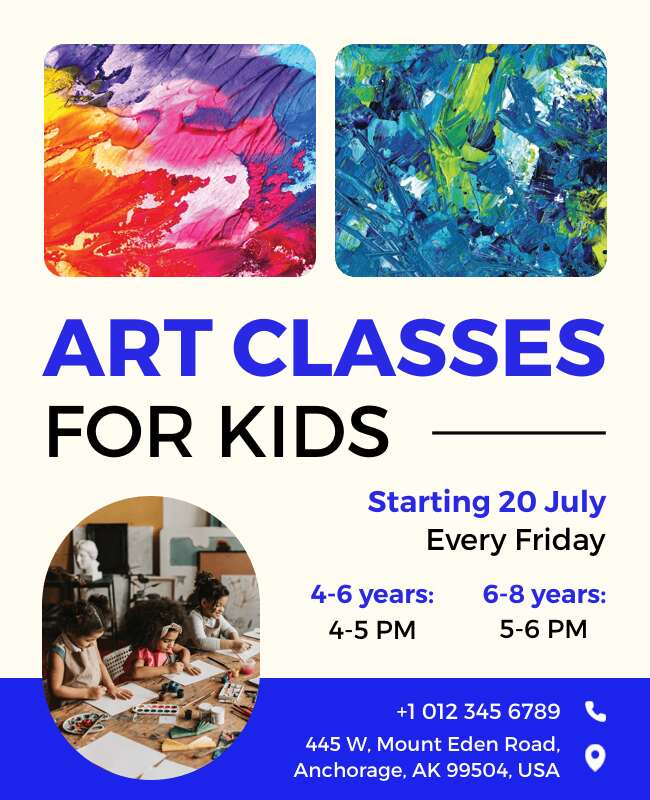
Simple Layout
- Hierarchy of Information: Highlight key information—such as class dates, times, and benefits—using larger fonts or bold text. This guides the reader’s attention to what’s most important.
- Ease of Reading: Keep the flyer organized and easy to read. A cluttered flyer can overwhelm potential students and deter interest.
- Balanced Composition: Use a clean layout that draws the eye naturally from one element to the next. Ensure there’s ample white space to prevent overcrowding.
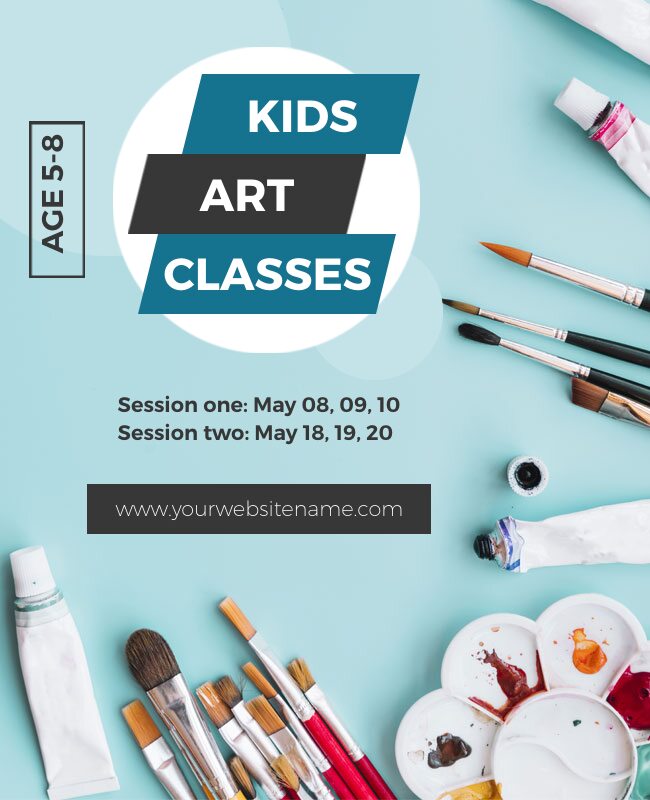
Key Information in Art Classes Flyers
You’ve captured their attention with a beautiful design, but now it’s crucial to ensure potential students understand exactly what you’re offering. Here’s how to present your information clearly and effectively:
Class Details
- Essential Information: Provide all key details in a format that’s easy to scan.
- Dates and Times: Clearly list the start and end dates, along with class times.
- Location: Include the venue or studio address.
- Price: State the cost of the class prominently.
- Highlight Important Info: Use bold or highlighted text for these details to make them stand out, allowing readers to quickly find what they need.
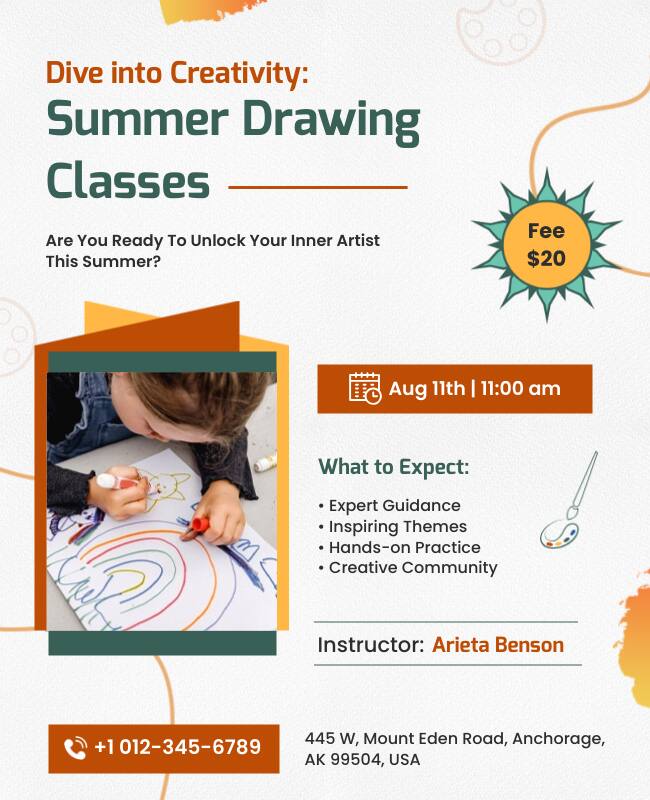
Call to Action
- Direct Instructions: Clearly tell potential students what to do next.
- Examples include phrases like “Sign Up Today”, “Reserve Your Spot”, or “Register Now”.
- Visibility: Ensure the CTA is noticeable—consider using a contrasting color or larger font for added emphasis. The CTA should be actionable and inviting, encouraging immediate response.

Class Description
- Engaging Overview: Include a few short sentences that describe what the class offers.
- Highlight Uniqueness: Mention what sets your class apart. Are you focusing on a specific technique, or do you offer a hands-on, interactive experience?
- Sneak Peek of Learning: Provide a glimpse into what students will learn, sparking their curiosity and excitement about the class.
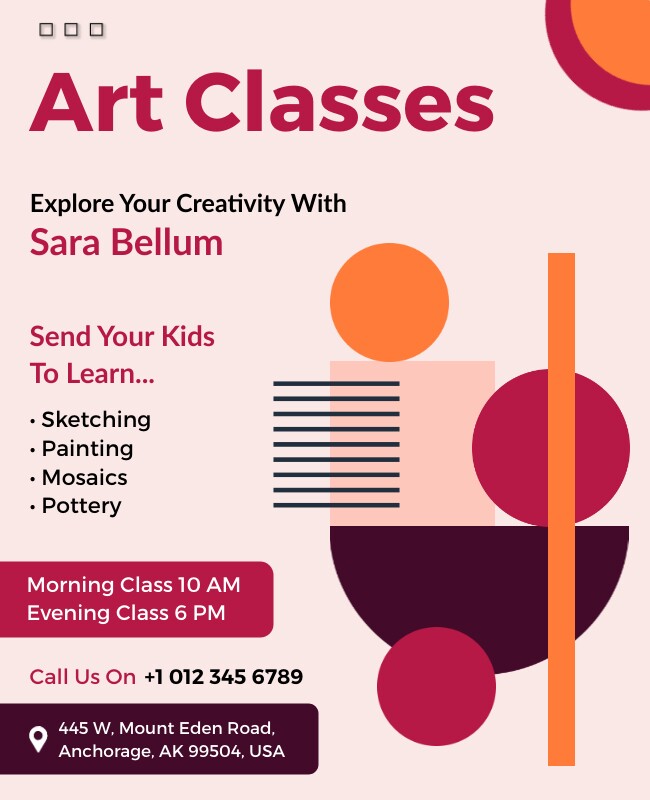
Strategy of Digital Art Classes Flyers
While print flyers are fantastic for local outreach, don’t overlook the digital realm. Many potential students will encounter your flyer online before seeing it in print. Here’s how to make the most of digital marketing for your flyer:
Create an Online Version
- Optimize for Digital: Design a digital version of your flyer with the use of editable flyer templates that are visually appealing and easy to share. Ensure it’s in a format suitable for various online platforms (e.g., JPEG, PNG, or PDF).
- Responsive Design: Make sure the flyer looks great on both desktop and mobile devices, as many users will view it on their smartphones.
Share on Social Media
- Platform Engagement: Post your flyer on social media platforms where your target audience is active, such as Facebook, Instagram, and Twitter.
- Relevant Hashtags: Incorporate hashtags like #artclasses, #paintingworkshop, or #drawingclasses to expand your reach and connect with interested individuals.
Email Marketing
- Targeted Outreach: Send the digital flyer to your existing student list. This keeps them informed about new offerings and encourages repeat enrollments.
- Referral Discounts:Offer discounts for referrals to encourage your current students to share the flyer with friends and family. This strategy not only increases visibility but also strengthens community engagement. Check out these discount flyer tips to make your promotional flyers even more impactful.
Where to Distribute Your Art Classes Flyers
Now that your flyer is beautifully designed and packed with information, the next step is distribution. Getting your flyer into the right hands is crucial for attracting students. Here are some effective places to distribute your art classes flyers:
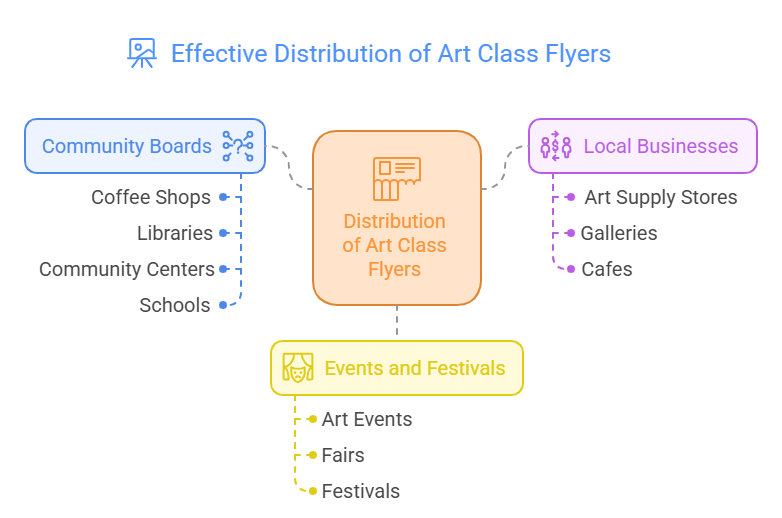
Community Boards
- Ideal Locations: Post your flyers in local coffee shops, libraries, community centers, and schools. These venues often have community boards where local events and classes are advertised.
- Professional Presentation: Always ask for permission before posting. Use pins or magnets to keep your flyers tidy and professional-looking.
Local Businesses
- Targeted Outreach: Approach businesses in the area where you’ll be teaching. This could include art supply stores, galleries, or cafes.
- Mutual Benefit: Many local businesses might be willing to display your flyer or distribute it to their customers, especially if it aligns with their clientele’s interests. Just like local artists might share your flyer with their face painting services flyer. It’s a simple way to get in front of the right people without heavy promotion.
Events and Festivals
- Engage with Your Audience: Partner and place your flyers with their local art events, fairs, festivals, or art exhibition flyers and this approach can be an excellent way to reach people already interested in art.
- Direct Interaction: Set up a booth or table at these events to distribute your art classes flyers and engage directly with potential students. This personal touch can significantly enhance interest and enrollment.
Measure and Improve: Art Classes Flyer Strategy
Tracking the effectiveness of your flyer strategy is essential to ensure you’re reaching the right audience and maximizing enrollment. Here’s how to measure success and make improvements:
Gather Feedback
- Ask New Students: When new students enroll, ask them how they found your class. Specifically, inquire if they saw your flyer and where it was displayed.
- Survey Responses: Consider creating a short survey for new students that includes questions about their awareness of your marketing efforts.
Analyze Distribution Methods
- Identify Successes: If a particular distribution method—like posting in local coffee shops—yields more responses, focus your efforts there.
- Adjust Accordingly: Allocate more resources to the most effective channels while reducing efforts in less successful areas.
Experiment with Designs and Messaging
- A/B Testing: Try out different flyer designs or messaging to see what resonates best with your audience. This could involve testing variations in colors, layouts, or calls to action.
- Collect Data: Keep track of which designs lead to higher enrollment rates or engagement levels. Use this data to inform future flyer designs.
Continuous Improvement
- Iterate Over Time: Understand that flyers are not a one-size-fits-all solution. The preferences and interests of your audience may evolve, so be prepared to adjust your strategy regularly.
- Stay Engaged: Keep an eye on trends in your community and adapt your flyers to address new interests or demands.
Conclusion
Designing the perfect art class flyer is all about connecting with your potential students and showing them what they’ll gain by joining your class. By knowing your audience, creating eye-catching designs, offering clear and valuable information, and distributing your flyer wisely, you can fill those seats faster than you can paint the first stroke of your next masterpiece.



